Chapter 1 Antarctic Visit Report
Introduction
1.1
In September 2012, the Minister for Sustainability, Environment, Water,
Population and Communities, the Hon Tony Burke MP, invited members of the Joint
Standing Committee on the National Capital and External Territories to take
part in a visit to Wilkins base in the Australian Antarctic Territory.[1]
The visit consisted of a kit-out, tour of inspection and briefing at the
Australian Antarctic Division (AAD) Headquarters at Kingston, Tasmania, on 12
December, followed by a return flight to Wilkins on 13 December. While at
Wilkins the Committee inspected the base facilities and a field camp.
1.2
During the visit, the Committee was able to hold discussions with a
range of AAD personnel and learn something of the scientific work being
undertaken in Antarctica. The Committee was also given the chance to experience
at first hand the challenges and rewards facing those working in the Australian
Antarctic Territory, especially the incredible logistical effort involved.
1.3
The Committee thanks the Minister for the opportunity to travel to the
Antarctic, and thanks the staff of the AAD for their efforts and support in
making the visit a rewarding experience for those involved.
Day 1—AAD Kingston
1.4
The day at AAD Headquarters, Kingston, involved a kit-out, inspections
and briefings. The Committee was also able to hold informal discussions with
AAD staff during the day, getting a picture of the current opportunities and
challenges facing the AAD.
1.5
The kit-out involved the issue of a complete set of survival clothing as
well as instructions upon how to pack it, how to wear it and when to put it on.
It was emphasised that the survival gear was vital to our welfare, was to be
worn at all times on the ice, and that no substitution with non-issue gear was
allowed.
1.6
The Committee conducted inspections of the set-up and preparations of
the Aurora Basin Deep Field Glaciology Camp, the AAD mechanical workshop, the
krill laboratory, as well as receiving a briefing on the manufacture and use of
whale tags.
1.7
The Aurora Basin Deep Field Glaciology Camp will generate climate data
from ice cores. The Committee was shown around camp facilities set up at
Kingston for demonstration and testing, as well as being shown ice core drills
and testing equipment. As part of the inspection, the committee was briefed on
the climate data already being produced from Antarctic ice cores, particularly
at Law Dome in the Australian Antarctic Territory. Four hundred metres of ice
core can give 4000 years of temperature data. The presence of various elements
in the core can give indications of solar activity, volcanic activity and winds
at different times. Concentrations of atmospheric gases can also be measured
over time. So too can the extent to which Antarctica is soaking up water or
releasing it to the ocean.
Figure 1.1 JSCNCET Members inspecting ice coring
equipment, AAD Kingston.
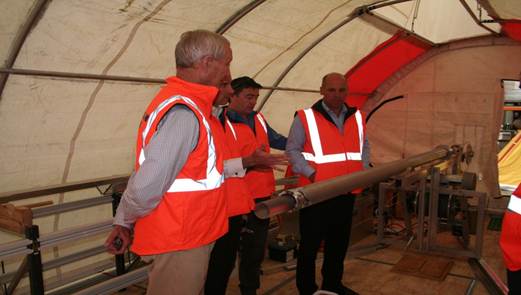
Source JSCNCET
12 December 2012
1.8
The findings presented to the Committee indicate that a slight decrease
in land ice has occurred in Antarctica, but that losses of sea ice in some
areas have been compensated by increases in other areas, reflecting variations
in ocean circulation. The records indicate an exponential increase in the
presence in the atmosphere of greenhouse gases such as methane, carbon-dioxide
and nitrous oxide since the year 1800. Carbon Dioxide is at its highest
concentration for 15 million years.
Figure 1.2 JSCNCET Members discussing climate data with Dr
Tas van Ommen, AAD.
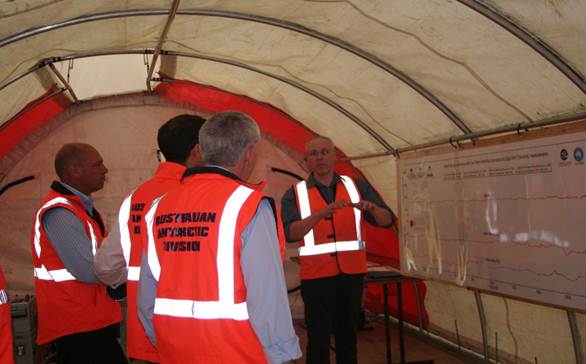
Source JSCNCET
12 December 2012
1.9
The krill laboratory looks at the lifecycle of krill and the
phytoplankton that feeds it. Phytoplankton plays a significant role in carbon
dioxide sequestration. Understanding the relationship between the Southern
Ocean, its inhabitants and the atmosphere is vital to understanding the process
of oceanic carbon sequestration.
1.10
Antarctic krill is the dominant herbivore biomass in the Southern Ocean.
It is essential for much higher animal life and also plays a part in the human
food chain. Information on the life cycle of krill provided by the laboratory
informs catch limits in the krill fishery.
1.11
AAD is playing a leading role in the tagging and monitoring of whales.
The Committee was given a demonstration of types of whale tags and the
development of tagging technology. The technology has been used to produce maps
illustrating the migratory patterns of humpback whales and will be employed in
future to allow scientists to monitor the movements of blue whales as part of
the Antarctic Blue Whale Project.
1.12
The Committee was also shown around the mechanical workshop where
vehicles and equipment are maintained and reconditioned for return to
Antarctica. The Committee inspected two Hägglunds over-snow vehicles which
provide the main motorised transport for AAD personnel in Antarctica. The two
vehicles had been in service for some thirty years.
Figure 1.3 JSCNCET Members inspecting the Mechanical
Workshop, AAD Kingston.
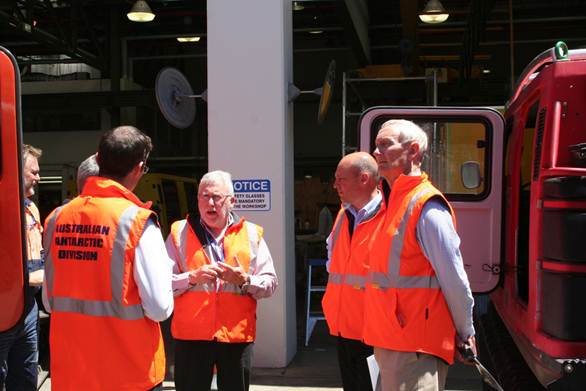
Source JSCNCET
12 December 2012
Day2—In-flight briefing—the work of the AAD
1.13
The in-flight briefing included an overview of Australia’s Antarctic
operations.
1.14
The Australian Antarctic Division was established in 1948, and moved
from Melbourne to Kingston in 1981. It employs around 300 staff in Tasmania and
between 70 and 200 staff in the Antarctic stations at any one time.
1.15
The four permanent stations are:
- Macquarie Island
- Mawson
- Established
1954
- Accommodation
for around 40 people
- 15 days
from Hobart by sea
- Davis
- Established
1957
- Accommodation
for around 100 people
- 12 days
from Hobart by sea
- Casey
- Established
1969 (replacing Wilkes)
- Accommodation
for around 100 people
- 8 days
from Hobart by sea;
- 65km from
Wilkins runway (4½ hours by air
from Hobart).
1.16
The three Antarctic mainland bases are crewed 365 days a year and are
regarded as high maintenance, requiring a year-round presence to ensure they
remain serviceable. Many of the design features are now considered out of date.
They are also energy intensive, a major drawback when all fuel supplies must be
shipped in and securely stored, at considerable cost.
1.17
Transport of equipment, stores and (until recently) personnel is chiefly
by sea. The Aurora Australis, launched in 1969 and operated by P&O,
is the platform for maritime transport and marine research for the AAD. It is
the sole Australian vessel supporting Australia’s Antarctic presence and is due
for a major refurbishment in 4 years.
1.18
The air link is principally for the movement of personnel and light
stores. The air link is via Wilkins runway, using an Airbus A319 operated by
Skytraders Pty Ltd. The Wilkins runway has had a chequered history since
becoming operational in January 2008—with as few as two flights per season
being completed—the operation of the runway being dependent on weather,
aircraft serviceability and, most importantly, the integrity of the runway
surface. Unusually warm temperatures in recent years have regularly rendered
the runway unusable. Three of the five seasons at Wilkins have been considered
failures, and other options for inter-continental transport are being explored.
1.19
Intra-continental air transport is by Basler T-67 and Twin Otter
aircraft operated by Kenn Borek Pty Ltd (Canada). The Baslers are converted
DC-3 aircraft and, while very effective, do not offer a long term transport
solution. Other options are being explored.
1.20
Helicopters also provide short-range and ship–to-shore transport.
1.21
Over 10 000 tonnes of cargo are carried to Australia’s four stations
each year. In 2011–12, over 444 passengers completed round trips by sea and/or
air, while another 100 travelled by sea alone. There were 51 520 occupied bed
nights at the four stations. 6.4 million litres of fuel were consumed for
electricity generation, shipping, aviation and vehicles. Transportation is
regarded as the single biggest cost of Australia’s Antarctic operations.
1.22
The AAD plays a significant role in the Tasmanian economy, with direct
spending of some $70 million per annum. AAD procures $15–20 million per annum
of goods and services from around 100 Tasmanian businesses. The Tasmanian
Antarctic sector employs around 900 people and is worth up to $200 million per
annum.
1.23
The in-flight briefing also focused on the changes to Antarctica and the
world revealed by 100 years of scientific endeavour. Committee members received
a small bottle of air extracted from ice-cores dating to 1912, the year of
Mawson’s Antarctic expedition. Antarctic science has revealed changes in the
atmosphere, changes in climate, and changes in the world’s oceans in the last
100 years. It has allowed us to hind-cast the world’s climate over tens of
thousands of years. It has revealed changes in ocean circulation and convection
which have a major influence on climate.
1.24
Science has also identified a collapse in fish stocks and the pelagic
whale population in the Southern Ocean in the last hundred years. Australian
Antarctic science has been at the forefront of supporting policy on sustainable
management of the Southern Ocean through research on the krill fishery,
reducing bird by-catch and non-lethal whale research.
1.25
Australian Antarctic science has also led the way in environmental
management through remediation efforts and biosecurity management.
1.26
There is a ten year strategic plan in place to provide direction to
Australian Antarctic science, with four basic themes:
- Climate Processes and
Change
- Terrestrial and
Nearshore Ecosystems: Environmental
Change and Conservation
- Southern Ocean
Ecosystems: Environmental Change and Conservation
- Frontier Science.
1.27
The focus of the strategy is on highly applied and effective science
with an emphasis on the link between science, policy and operations, with all
projects being selected on a competitive basis to fulfil these requirements.
There is also a high level of emphasis on international co-operation, which is
seen as essential to the future of Antarctic science.
1.28
Current projects being run from Casey Station include:
- Aurora Basin
North ice coring. This project will recover an ice core from a new site in
the interior of East Antarctica, providing data covering 2000 years and filling
a gap in the current array of Antarctic climate records.
- Law Dome Summit
Snow–Climate Observatory. This will update the high resolution Law Dome ice
core data, allowing calibration with meteorological data.
- High resolution
studies of cosmogenic beryllium isotopes at Law Dome. Study of naturally
occurring radioactive beryllium isotopes provide a means of reconstructing
solar output, and thereby the impact of the solar cycle and changes in the
Sun’s impact on climate over time.
- Remediation of
petroleum contaminants in the Antarctic and sub-Antarctic. A long term
program looking at implementation, risk assessment and monitoring of full-scale
remediation operations of fuel contamination in the Antarctic and
sub-Antarctic.
- Development of
contaminant metal removal systems suitable for implementation in cold regions.
This project will develop materials and methods for the stabilization and
removal of metal contaminants from contamination sites in cold regions.
- Development of
environmental risk assessment and remediation guidelines for Antarctic and
sub-Antarctic marine and terrestrial environments. This project will build
on limited ecotoxicological data currently available for Antarctic biota to
develop Environmental Risk Assessment procedures and to derive soil and water
quality guidelines and remediation targets.
- Residual toxicity
and risk assessment of petroleum hydrocarbons in Antarctic and sub-Antarctic
soils. This study will evaluate the toxicity of fuels as they degrade. The
project will identify safe levels of contamination where no environmental risk
remains and provide targets for cleaning up contaminated sites.
- Modelling spatial
patterns and identifying environmental drivers for temporal change in Antarctic
moss communities. The project will use existing and new data to model
spatial and temporal variation of mosses and lichens, identify the
environmental drivers that determine their current locations, and predict the
species that are most at threat from station activities and future climate
scenarios.
- ICECAP
(Investigating Cryospheric Evolution through Collaborative Aerogeophysical
Profiling in the Australian Antarctic Territory). This project explores ice
sheet structure, Antarctic bedrock and changing ice volume to answer key
questions about Antarctica and current and future sea-level rise. ICECAP has
already revealed a great deal about the geography of the East Antarctic Ice
Sheet.
- Monitoring the
status and trends of Antarctic seabirds to improve fisheries management and
detect climate change impacts in east Antarctica. This project aims to
develop and apply cost-effective monitoring approaches to determine population
status and trends of a range of seabirds across the AAT.
- Greenhouse gases
in the southern hemisphere. Part of CSIRO’s background air monitoring
network, the Antarctic region is well located to measure global background
changes in greenhouse gases.
Day 2—Wilkins
1.29
The Committee departed from Hobart at 5am for the 4½ hour flight to
Wilkins runway. Survival gear was donned during the flight. Upon arrival, the
Committee was briefed on ground conditions (-8 degrees C, winds 25–30 knots,
and cloudy).
Figure 1.4 Wilkins Aerodrome, AAT.
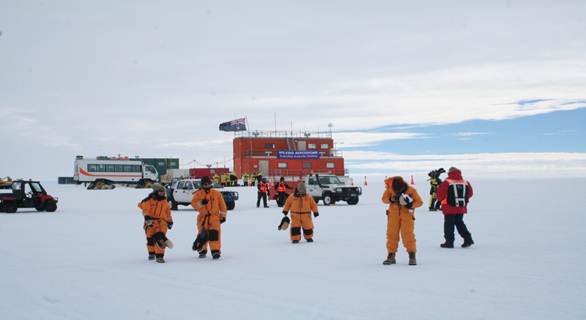
Source JSCNCET
13 December 2012
1.30
The Committee inspected a demonstration field camp for an ice-coring
site, complete with one–person accommodation tent, ablutions tent, and ice core
equipment. The field-camp gave the Committee a brief taste of the conditions
faced by researchers and support staff working in the field. Transportation to
and from the field camp was on the snow bus ‘Priscilla’.
Figure 1.5 Members of the JSCNCET, SSCEC and AAD staff
inspecting field camp.
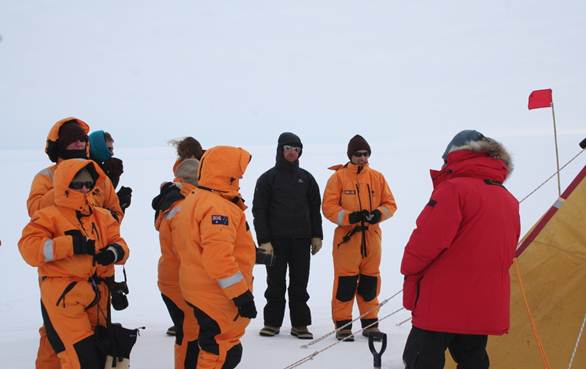
Source JSCNCET
13 December 2012
1.31
The Committee was then shown around the base facilities at the Wilkins
runway, including the main runway building and the accommodation block, with
its basic and confined but otherwise comfortable facilities, and the various
machines required to maintain the runway.
1.32
After approximately two hours on the ice, the Committee boarded the
plane for the return flight to Hobart.
Figure 1.6 The Airbus A319 on Wilkins Runway.
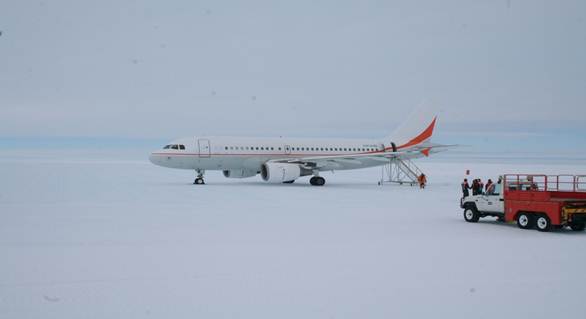
Source JSCNCET
13 December 2012
Committee conclusions
1.33
The Committee is grateful for the opportunity to have seen the work of
Australia’s Antarctic scientists and support staff at first hand. The visit to
the Australian Antarctic Division’s facilities at Kingston and flight to
Antarctica was an informative and rewarding experience for all those who
attended.
1.34
Perhaps the most important point to come out of the visit from the
Committee’s point of view is the great work of the men and women of the AAD.
The Committee was impressed by the dedication, enthusiasm and professionalism
of everyone they met. The AAD and Australia’s Antarctic and marine scientists
are responsible for world-leading and ground-breaking research. It is a record
of achievement of which the nation can be justifiably proud.
1.35
Nonetheless, there are challenges facing Australia if it wishes to
remain one of the leading scientific influences in Antarctica.
1.36
First is the issue of logistics. The Committee got first-hand experience
of the sheer logistical effort required to do anything in Antarctica, let alone
conduct world-class scientific research. The challenges presented by ageing
equipment and facilities, the regular failure of the Wilkins runway, and the
need for more diverse transport options, must be met if Australia is to compete
with existing and emerging Antarctic nations. Australia must modernise the
transport and infrastructure supporting Australia’s Antarctic
presence—including new ship(s), new air transport options, modern base
facilities, and better access to the Antarctic inland. Moreover, the planning
and funding for this new generation of bases and equipment must begin now.
1.37
Second is the need to maintain Australia’s Antarctic and Southern Ocean
research effort. Australia is a leader in environmental and climate science in
Antarctica because of a sustained bi-partisan commitment to Antarctic science.
This commitment must be maintained and funding continued, at the very least, at
current levels in real terms, so that Australia can maintain pre-eminence in
these fields. The Committee believes that the significance of Australia’s
Antarctic science cannot be overstated.
1.38
This is not merely a matter of research and logistics but of strategic
necessity. Australia’s continued claim to the Australian Antarctic Territory is
hollow without a strong and enduring scientific and logistical presence on the
Antarctic continent. Effectively, Australia must use the AAT or lose it.
1.39
This in no way suggests that Australia should seek to exclude other
nations from the AAT or reduce the emphasis on international collaboration in
research. Rather, it is to acknowledge that Australia’s Antarctic claim rests
upon its leadership, and continued leadership requires investment in
cutting-edge science and logistics.
1.40
To this end, the Committee welcomes statements by Minister Burke
supporting the scientific research effort and acknowledging the importance of
logistics, including marine and air transport capabilities.[2]
1.41
The Committee also acknowledges Australia’s leading role in research on
waste management and pollution remediation. Protecting the near pristine
Antarctic environment and minimising the impact of human activities should be a
priority for all activities in the Antarctic. Finding ways to reduce the human
footprint through better technology, more careful management, and effective
remediation, is vital.
1.42
Finally, the Committee wishes to restate its ongoing interest in the
work of the AAD and the future of the AAT. The Committee has a strong interest
in the Antarctic Treaty System (ATS), its implications for Australia, and its
role in the management and protection of Antarctica and the Southern Ocean. The
ATS is vital to Australia’s interests, especially with the growing presence of
new Antarctic nations within and outside the AAT. The Committee is conscious of
the scientific research effort, of the need to maintain Australia’s leadership
in fields such as climate science and environmental management, and the opportunities
to explore new fields, such as Antarctic astronomy. The Committee is also
conscious of the logistic systems underpinning Australia’s scientific effort,
and the need for new and ongoing investment in transport and infrastructure if
the scientific effort is to be maintained. Waste management is a significant
and ongoing issue; as is the future of Antarctic tourism with its potential
impacts on the Antarctic environment. These are all areas the Committee expects
to investigate further in the not-too-distant future.
Senator Louise Pratt
Chair
13 March 2013